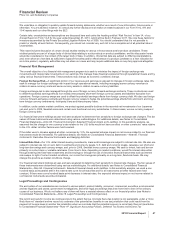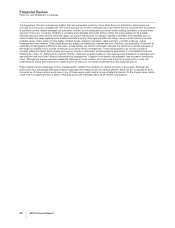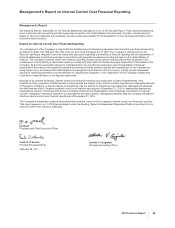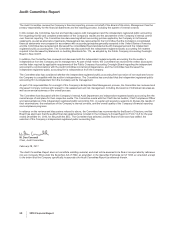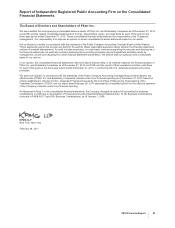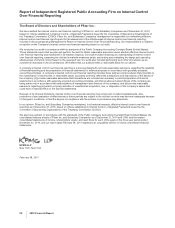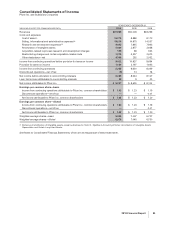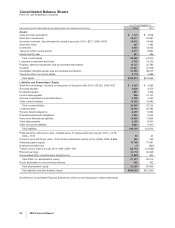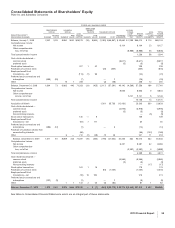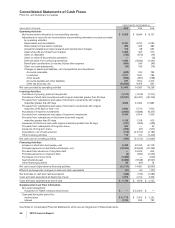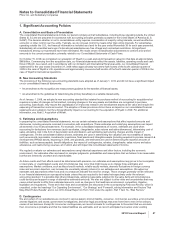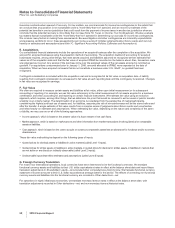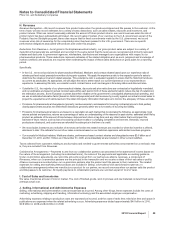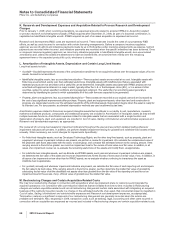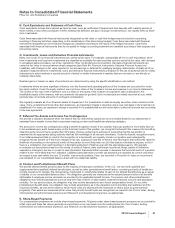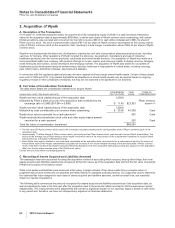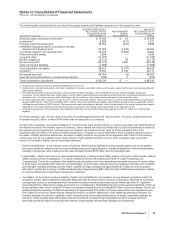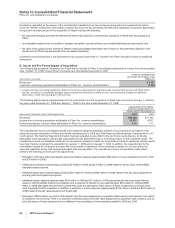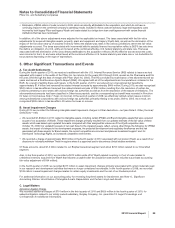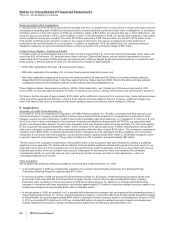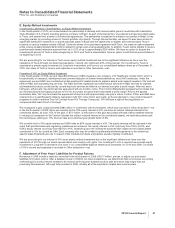Pfizer 2010 Annual Report Download - page 59
Download and view the complete annual report
Please find page 59 of the 2010 Pfizer annual report below. You can navigate through the pages in the report by either clicking on the pages listed below, or by using the keyword search tool below to find specific information within the annual report.
Notes to Consolidated Financial Statements
Pfizer Inc. and Subsidiary Companies
1. Significant Accounting Policies
A. Consolidation and Basis of Presentation
The consolidated financial statements include our parent company and all subsidiaries, including those operating outside the United
States (U.S.) and are prepared in accordance with accounting principles generally accepted in the United States of America (U.S.
GAAP). The decision whether or not to consolidate an entity requires consideration of majority voting interests, as well as effective
economic or other control over the entity. Typically, we do not seek control by means other than voting interests. For subsidiaries
operating outside the U.S., the financial information is included as of and for the year ended November 30 for each year presented.
Substantially all unremitted earnings of international subsidiaries are free of legal and contractual restrictions. All significant
transactions among our businesses have been eliminated. We made certain reclassification adjustments to conform prior period
amounts to the current presentation, primarily related to our Consolidated Statements of Cash Flows.
On October 15, 2009, we completed our acquisition of Wyeth in a cash-and-stock transaction valued on that date at approximately
$68 billion. Commencing from the acquisition date, our financial statements reflect the assets, liabilities, operating results and cash
flows of Wyeth. As a result, and in accordance with our domestic and international fiscal year-ends, our consolidated financial
statements for the year ended December 31, 2009 reflect approximately two-and-a-half months of the fourth calendar quarter of
2009 in the case of Wyeth’s U.S. operations and approximately one-and-a-half months of the fourth calendar quarter of 2009 in the
case of Wyeth’s international operations.
B. New Accounting Standards
The provisions of the following new accounting standards were adopted as of January 1, 2010 and did not have a significant impact
on our consolidated financial statements:
•An amendment to the recognition and measurement guidance for the transfers of financial assets.
•An amendment to the guidelines for determining the primary beneficiary in a variable interest entity.
As of January 1, 2009, we adopted a new accounting standard that retains the purchase method of accounting for acquisitions but
requires a number of changes to that method, including changes in the way assets and liabilities are recognized in purchase
accounting. Specifically, they require the capitalization of in-process research and development assets at fair value and require the
expensing of transaction costs as incurred. The adoption of these provisions did not have an impact on our consolidated financial
statements upon adoption, but they did significantly impact our accounting for the acquisition of Wyeth in 2009. For additional
information, see Note 2. Acquisition of Wyeth.
C. Estimates and Assumptions
In preparing the consolidated financial statements, we use certain estimates and assumptions that affect reported amounts and
disclosures, including amounts recorded in connection with acquisitions. These estimates and underlying assumptions can impact
all elements of our financial statements. For example, in the consolidated statements of income, estimates are used when
accounting for deductions from revenues (such as rebates, chargebacks, sales returns and sales allowances), determining cost of
sales, allocating cost in the form of depreciation and amortization, and estimating restructuring charges and the impact of
contingencies. On the consolidated balance sheets, estimates are used in determining the valuation and recoverability of assets,
such as accounts receivables, investments, inventories, fixed assets and intangible assets (including acquired in-process research &
development (IPR&D) assets, beginning in 2009, and goodwill), and estimates are used in determining the reported amounts of
liabilities, such as taxes payable, benefit obligations, the impact of contingencies, rebates, chargebacks, sales returns and sales
allowances, and restructuring reserves, all of which also will impact the consolidated statements of income.
We regularly evaluate our estimates and assumptions using historical experience and other factors, including the economic
environment. Our estimates often are based on complex judgments, probabilities and assumptions that we believe to be reasonable
but that are inherently uncertain and unpredictable.
As future events and their effects cannot be determined with precision, our estimates and assumptions may prove to be incomplete
or inaccurate, or unanticipated events and circumstances may occur that might cause us to change those estimates and
assumptions. Market conditions, such as illiquid credit markets, volatile equity markets, dramatic fluctuations in foreign currency
rates and economic downturn, can increase the uncertainty already inherent in our estimates and assumptions. We adjust our
estimates and assumptions when facts and circumstances indicate the need for change. Those changes generally will be reflected
in our financial statements on a prospective basis unless they are required to be treated retrospectively under the relevant
accounting standard. It is possible that other professionals, applying reasonable judgment to the same facts and circumstances,
could develop and support a range of alternative estimated amounts. We also are subject to other risks and uncertainties that may
cause actual results to differ from estimated amounts, such as changes in the healthcare environment, competition, litigation,
legislation and regulations. These and other risks and uncertainties are discussed in the accompanying Financial Review, which is
unaudited, under the headings “Our Operating Environment”, “Our Strategy” and “Forward-Looking Information and Factors That
May Affect Future Results” and in our 2010 Annual Report on Form 10-K under the caption, Part 1 Item 1A. “Risk Factors.”
D. Contingencies
We and certain of our subsidiaries are involved in various patent, product liability, consumer, commercial, securities, environmental
and tax litigations and claims; government investigations; and other legal proceedings that arise from time to time in the ordinary
course of our business. Except for income tax contingencies, we record accruals for contingencies to the extent that we conclude
their occurrence is probable and that the related liabilities are estimable, and we record anticipated recoveries under existing
2010 Financial Report 57


